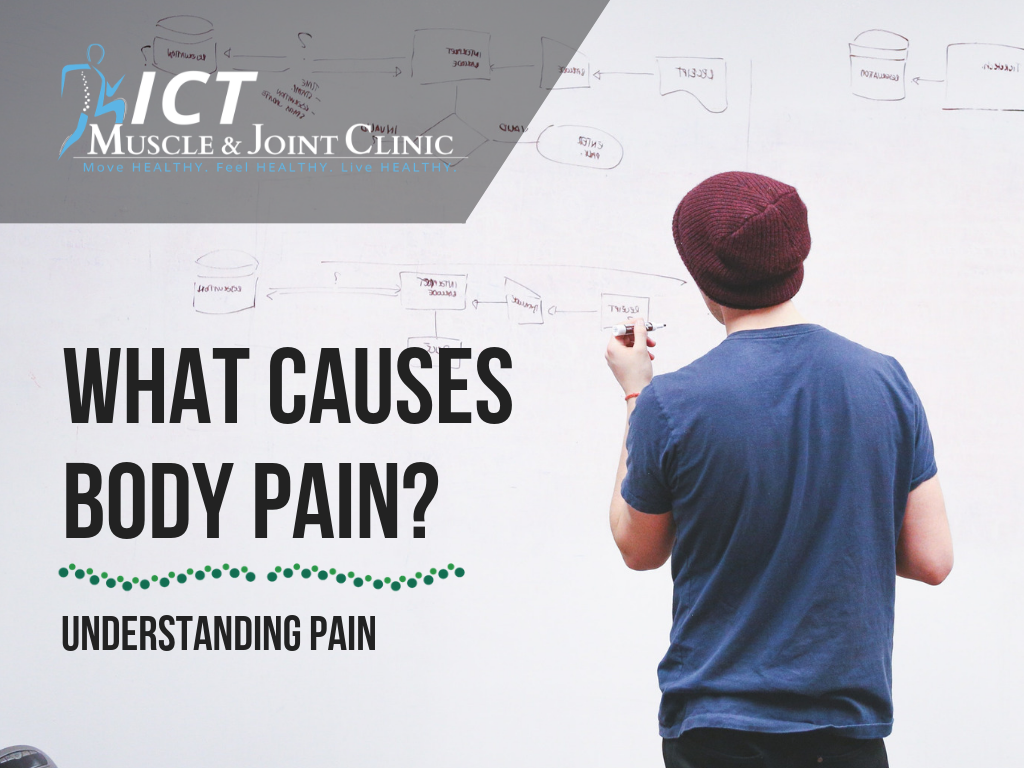What Causes Pain to the Body: Understanding Pain Handout
WHAT CAUSES PAIN TO THE BODY?
There are two, main mechanical (movement-based) pain causes: inflammation and tight soft tissue(s). The medical term for tight soft tissue is ischemia. Soft tissue is everything besides bone (ie hard tissue). The third category, highlighted in our overall overview of pain, is directed to the nerves – specifically the peripheral nerves. These are the nerves outside of your spine.
INFLAMMATION
Inflammation is an increase in fluid within an area. Inflammation is typically seen as swollen and red and might feel warm to the touch. There are two types of inflammation: mechanical and chemical. Inflammation is always felt as a constant pain with a dull, achy, or throbbing symptom attached.
Identifying Mechanical Inflammation
Mechanical inflammation is a type of inflammation that can get better OR worse with movement. If you can find a way to move the joint and surrounding tissue to feel better, then you are experiencing mechanical inflammation.
Treatment for Mechanical Inflammation
At home, the treatment goal would be to move the joint and surrounding tissues in a way to make it feel better without going overboard (read more). Your chiropractic doctor’s goal is to help you identify the correct direction of movement and prescribe the correct number of reps, so you won’t go overboard. Ask you chiropractor about other treatment options in the office that can help you recover faster.
Identifying Chemical Inflammation
Chemical inflammation looks exactly like mechanical inflammation. The best way to distinguish mechanical vs chemical inflammation is to move the joint. If your symptoms get worse with all directions of movement then it most likely is chemical inflammation.
Treatment for Chemical Inflammation
The old acronym RICE (rest, ice, compress, elevate) may be the best treatment approach at first. However, ice and rest are starting to become very questioned as a good treatment approach. A diet high in anti-inflammation foods, spices, and supplements are best. When chemical inflammation is present you need a chemical intervention to turn off the chemical pain receptors. However, your chiropractor may prescribe other services such as Dry Needling which has been shown to improve the release of your body’s natural opioid pathways. If the problem at hand is large enough, your chiropractor may refer you out to your family doctor or specialist for a cortisone injection or other, stronger anti-inflammatory options.
TIGHT SOFT TISSUES
The medical term for tight soft tissues is ischemia. Ischemia is caused by poor blood flow and oxygen to the tissues (ie muscles, ligaments, fascia, etc).
Identifying Ischemic Tissues
This is simple, if it feels tight while moving then it most likely is tight. Typically this is felt at the end range of movement.
Treatment for Ischemia
Your chiropractor will be help direct your efforts in the best way to loosen these tight tissues. It may include a combination of at home exercises/stretch and services such as adjusting, A.R.T. and Dry Needling in the office. It all depends on where the tension is coming from and where the tissue(s) are in the phases of healing.
NERVE PAIN
This category of pain is what has largely led us into an opioid addiction here in the United States. Nerve pain can be very complex, especially when treated incorrectly over a long period of time.
Identifying Nerve Pain
Nerve pain can feel like many different things. Nerve pain can feel like: numbness, tingling, shoot, electric, cold, etc. The list goes on. This is due to nerve pain being a combination of both inflammation and ischemia. The difference between nerve pain and inflammation pain is there are no visual signs. Often, people state things like “I have no idea what caused this pain.” This is nerve pain.
Treatment for Nerve Pain
Nerve pain treatment is directed at treating mobility and inflammation inside the nerve and the compression of different tissues surrounding the nerve. Your chiropractor may prescribe similar anti-inflammation strategies as seen in inflammation pain but will also provide services like McKenzie, nerve flossing exercises, chiropractic adjustments, and Dry Needling to relieve your nerve pain. The goal for treatment is to identify everywhere the nerve is getting pinched and then apply the appropriate strategy to un-pinch the nerve.
Movement-based Pain Overview
Movement-based pain falls into three categories: inflammation, overtight soft tissues, and nerve pain. Each pain category is unique with their own symptoms and treatment approach. However, all of these can overlap at the same time with each other and the central nervous system pain categories. Because of pain’s complexity, many individuals may go for long periods of time before finding the right specialists to help improve their quality of life. If you have questions, please contact us. We are always here for our patients in the greater Wichita, KS area!
About the author
Dr. Keith Sparks is an award-winning chiropractor, functional medicine expert, and the co-founder of ICT Muscle & Joint Clinic. Dr. Sparks’ emphasis of care originated within the fields of rehabilitation, soft-tissue therapies, and chiropractic. To date, he has brought this unique combination of skills into union with functional medicine. The sole purpose of intertwining these distinct skills, knowledge, and services is to provide incomparable care to his local community. Dr. Keith Sparks is often seen in the Wichita, KS community speaking at business events and teaching health and performance classes.
